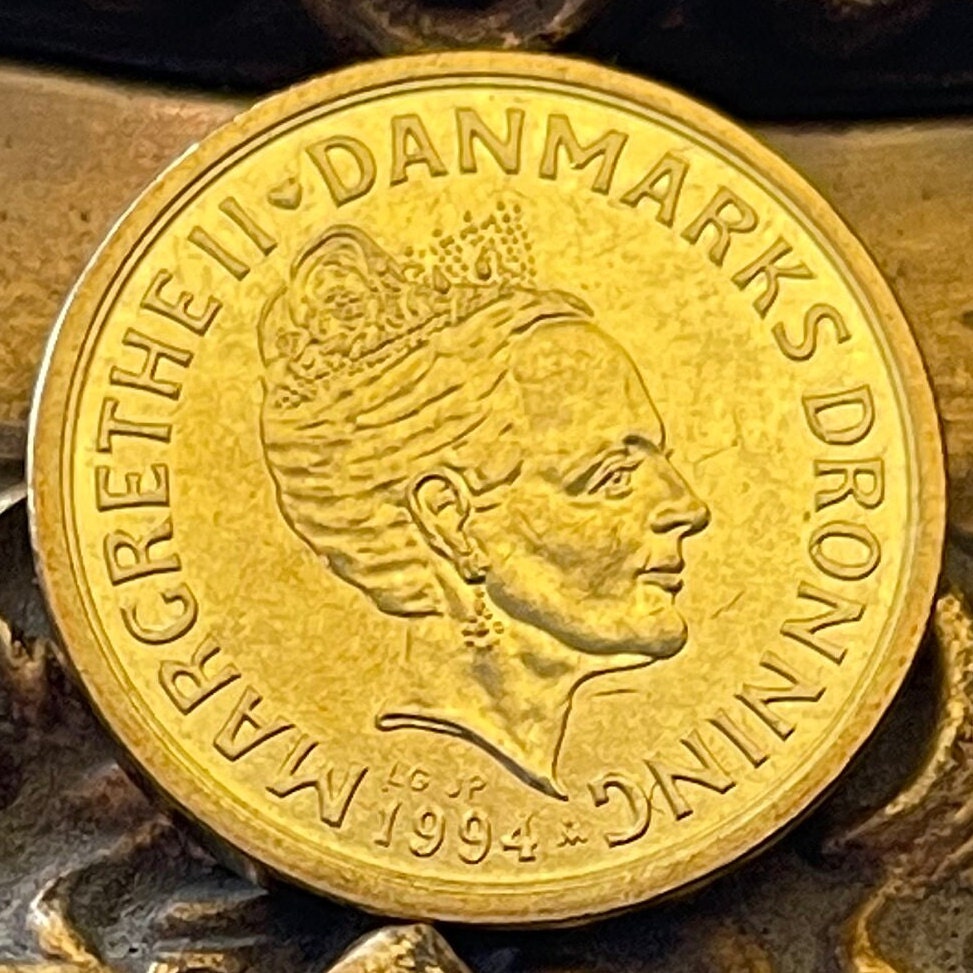elemintalshop
Queen Margrethe II 10 Kroner Denmark Authentic Coin Money for Jewelry and Craft Making (Three Lions)
Queen Margrethe II 10 Kroner Denmark Authentic Coin Money for Jewelry and Craft Making (Three Lions)
Couldn't load pickup availability
Queen Margrethe II 10 Kroner Denmark Authentic Coin Money for Jewelry and Craft Making (Three Lions)
Obverse: Portrait of Queen Margrethe II looking right
Lettering: MARGRETHE II ♥ DANMARKS DRONNING
Translation: Margrethe II Denmark's Queen
Reverse: Value, Crowned Denmark coat of arms in circle, ornamental decoration
Lettering: 10 KRONER
Features
Issuer Denmark
Queen Margrethe II (1972-date)
Type Standard circulation coin
Years 1994-1999
Value 10 Kroner
10 DKK = USD 1.53
Currency Krone (1873-date)
Composition Aluminium-bronze
Weight 7 g
Diameter 23.35 mm
Thickness 2.3 mm
Shape Round
Technique Milled
Orientation Medal alignment ↑↑
Number N# 1460
References KM# 877, Schön# 96
Wikipedia:
Margrethe II; Margrethe Alexandrine Þórhildur Ingrid, born 16 April 1940) is Queen of Denmark and commander-in-chief of the Danish Defence.
Born into the House of Glücksburg, a cadet branch of the House of Oldenburg, Margrethe is the eldest child of Frederick IX of Denmark and Ingrid of Sweden. She became heir presumptive to her father in 1953, when a constitutional amendment allowed women to inherit the throne. Margrethe succeeded her father upon his death on 14 January 1972. On her accession, she became the first female monarch of Denmark since Margrethe I, ruler of the Scandinavian kingdoms in 1375–1412 during the Kalmar Union. In 1967, she married Henri de Laborde de Monpezat, with whom she had two sons: Crown Prince Frederik and Prince Joachim.
Margrethe is known for her strong archaeological passion and has participated in several excavations, including in Italy, Egypt, Denmark and South America. She shared this interest with her grandfather Gustaf VI Adolf of Sweden, with whom she spent some time unearthing artefacts near Etruria in 1962.
As of 2021, Margrethe has, as sovereign, received 42 official state visits and she has undertaken 55 foreign state visits herself. She and the royal family have made several other foreign visits.[4] Support for the monarchy in Denmark has been and remains consistently high at around 82%, as does Margrethe's personal popularity.
******
The state coat of arms (Danish: rigsvåben) consists of three pale blue lions passant wearing crowns, accompanied by nine red lilypads (normally represented as heraldic hearts), all in a golden shield with the royal crown on top.
History
The oldest known depiction of the insignia dates from a seal used by King Canute VI . The oldest documentation for the colours dates from c. 1270.
Historically, the lions faced the viewer and the number of hearts was not regulated and could be much higher. The "heart" shapes originally represented waterlily pads; a royal decree of 1972 still specifies these figures as Danish: [[seeblatt|søblad]]e ("lake leaves").
The current design was adopted in 1819 during the reign of King Frederick VI who fixed the number of hearts to nine and decreed that the heraldic beasts were lions, consequently facing forward. A rare version exists from the reign of king Eric of Pomerania in which the three lions jointly hold the Danish banner, in a similar fashion as in the coat of arms of the former South Jutland County.Until, Denmark used both a "small" and a "large" coat of arms, similar to the system still used in Sweden. The latter symbol held wide use within the government administration, e.g., by the Foreign Ministry. Since this time, the latter symbol has been classified as the coat of arms of the royal family, leaving Denmark with only one national coat of arms, used for all official purposes.
The crown on the shield is a heraldic construction based on the crown of King Christian V, not to be confused with the crown of King Christian IV. The main difference from the real crown is that the latter is covered with table cut (Danish: taffelsten) diamonds rather than pearls. Both crowns, and other royal insignia, are located in Rosenborg Castle in Copenhagen.
The blazon in heraldic terms is: Or, three lions passant in pale azure crowned and armed Or langued gules, nine hearts Gules.
Source: https://everything.explained.today/Coat_of_arms_of_Denmark/
Share



















